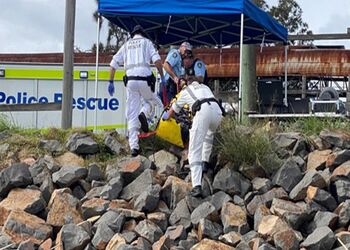Cocaine found around Australia’s coastlines have shone a spotlight on a variety of methods apparently used to smuggle it from South America.
On May 15, two men were arrested in Port Hedland, a remote coastal town in northwestern Australia, in possession of 320 kilograms of cocaine, according to a police press release. The men were found in a campervan filled with the drugs, estimated to have a street value of around $90 million, which they reportedly intended to sell across much of the country.
According to the report, the two suspects rented a boat and sailed 28 kilometers out to sea on two occasions last week, likely to retrieve the drugs. The boat was spotted next to a large bulk cargo ship from which the cocaine was seemingly transferred.
This is but the latest in a series of cocaine seizures in the country. On May 9, roughly 54 kilograms of cocaine were found in parcels on the banks of the Hunter River, on an island that forms part of Australia’s sprawling Newcastle Port.
Authorities located the packages where an unconscious diver was pulled from the water who, according to The Sydney Morning Herald, died despite the efforts of paramedics.
The diver was found with advanced scuba equipment on his person, including a rebreather which allows divers to remain underwater longer, reduce their noise levels and stop them from releasing bubbles.
SEE ALSO: Mexico-Australia Meth Connection Reveals Fresh Crime Dynamics
Local media posited that the individual had likely been recovering cocaine dispatched from a cargo ship that had previously arrived from Argentina. Such allegations are in keeping with previous cases where the Southern Cone nation has served as a launching point for Oceania-bound cocaine shipments.
Just over a month prior, Australian Federal Police broke the regional record for the largest drug seizure in South Australia, uncovering 416 kilograms of cocaine dropped from a cargo ship.
Newcastle, in turn, has previously made headlines for its role in Australia’s cocaine trade, having witnessed a 1.89 ton seizure in 2020. Accounting for the largest ever recorded seizure in the country, the substance was located aboard a fishing vessel off the coast of the port city.
InSight Crime Analysis
Seeking to more consistently penetrate the final frontier of cocaine markets, Latin American traffickers have laid the groundwork for more effective cocaine shipments to Australia.
An exceptionally lucrative destination, average prices per kilogram have climbed in recent years with the Australian Criminal Intelligence Commission reporting numbers as high as $278,000 in 2021, more than tripling figures seen in European markets.
This helps offset the costs incurred by sheer distance and logistical expertise required to ship cocaine to the land down under. Such undertakings require not only efforts from powerful organizations like the Sinaloa Cartel and Colombia’s Urabeños, but also a collaborative relationship with local organized crime to receive, house and distribute the drug in retail markets.
InSight Crime spoke to Dr. John Coyne, head of strategic policing and law enforcement at the Australia Strategic Policy Centre, about the relationships these groups have forged to feed growing demand for cocaine consumption.
SEE ALSO: LatAm Drug Traffickers Take Aim at New Zealand, Australia
In the Oceania region, Australia and New Zealand account for over 90 percent of the cocaine market, according to the United Nation’s latest report on global drug trends.
That market has traditionally been “extremely amorphous” according to Coyne. “Outlaw motorcycle gangs are a critical component of the retail and national level drug distribution frameworks,” he explained. However, Italian, Middle Eastern and Chinese crime groups all maintain footholds in the cocaine market with no dominant purchasing partner for Latin Americans to choose from.
In contrast, neither Mexican cartels nor South American groups enjoy a strong presence in Australia, forcing them to collaborate with local distributors. “I think they’re involved, but very thin on the ground,” Coyne stated, adding that Latin American traffickers remain “very under the radar and very much at the upper levels of distribution and the sales, never putting their hands on any deal.”
Using the Port of Newcastle as an entry point for the cocaine trade is a no-brainer. Approximately two hours north of one of the country’s larger drug markets, Sydney, the area houses facilities for one of Australia’s busiest maritime nodes and the largest coal port in the world.
Coyne also highlighted how the port lacks the security capabilities of Port Botany, the other industrial-scale port based in the region. “There’s a slight vulnerability there in contrast to other ports and a large amount of sailing traffic in which to hide imports,” he stated, making it a natural destination for traffickers.

